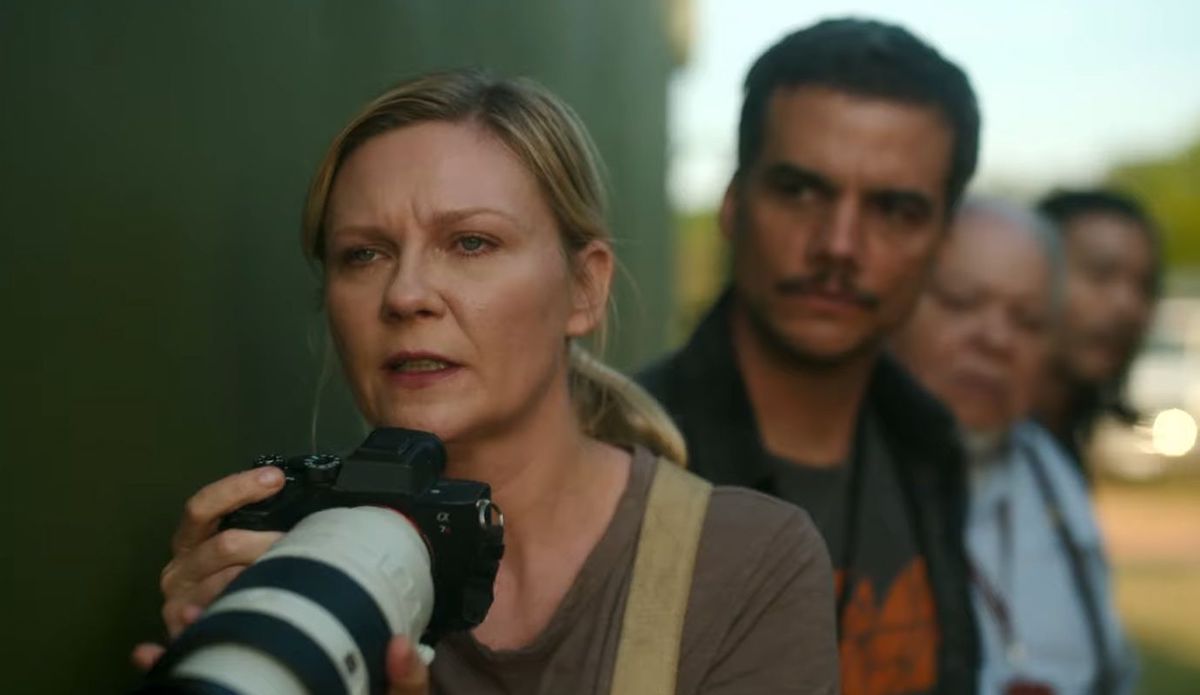Alex Garland’s ‘Civil War’ Is a Riveting, Explosive Cautionary Tale for America
5/5 cameras.

Alex Garland’s latest film Civil War is not what you think it is. The Annihilation and Ex Machina director’s new film is being advertised as a dystopian “what if” that imagines the modern United States in the throes of a second Civil War.
And for anyone paying attention to the last decade of American politics, it’s not that hard to imagine. From Trump’s attempted dictatorship to the January 6th insurrection, American democracy is on shakier ground than ever. However, the political conflict behind the civil war is not Garland’s focus. We never find out why California and Texas, now known as the Western Forces, are seceding from the U.S. We suspect it has something to do with the three-term power-hungry POTUS, played effectively by Nick Offerman. But Civil War isn’t interested in the story behind the conflict.
The film focuses on two veteran war journalists, adrenaline-seeking writer Joel (Wagner Moura) and veteran photojournalist Lee (Kirsten Dunst). While Joel maintains enthusiasm for their work, Dunst is all numb exhaustion, haunted by a lifetime of documenting humanity at its darkest. As the final days of the war rage on, Joel and Lee depart New York for Washington, D.C. to interview the president. Hitching a ride with them is older New York Times journalist Sammy (Stephen McKinley Henderson) and fledgling shutterbug Jessie (Cailee Spaeny) who idolizes Lee.
The foursome embark on their tour through the war-ravaged Northeast, shadowing armed conflicts, passing through military checkpoints, and chronicling the horrors of war. Garland stages these combat scenes with a breathless intensity and a vérité-style reminiscent of Alfonso Cuarón’s excellent Children of Men. The sound design and mixing ratchet up the intensity, putting viewers in the firing zone and emphasizing the sensory chaos of battle. This, coupled with the film’s moments of brutal violence, is almost assaultive to the audience.
But that is, of course, the point. Garland juxtaposes these horrors with peaceful scenes at a football stadium turned refugee camp. In their travels, the crew stumble upon a small town seemingly untouched by the war. The town’s insistence on normality is its own kind of unsettling, especially when you discover that they’re guarded by rooftop militia. The film roils with tension, and every scene has the potential to spill into harrowing violence.
Through their travels, the crew documents the horrors of war that we’ve become all too familiar with, like bombed-out cities, tortured captives, and mass graves. They’re the images you scroll through daily while reading the news. Civil War has a lot to say, but at its core is a tribute to the brave war journalists who put themselves in harm’s way to report the news. It’s an essential duty that relies on capturing the moment no matter how bleak, where overriding one’s instinctual empathy is required to survive. The film also forces viewers to contend with the real victims of war, the vulnerable, the unarmed, and the marginalized communities. Because every war, every armed conflict, no matter how “just”, ends with massive civilian casualties and generational trauma. By bringing the iconography of war to America, Garland makes it impossible to look away.
(featured image: A24)
Have a tip we should know? tips@themarysue.com